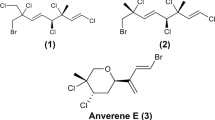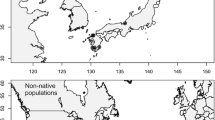Abstract
Five of the most common macrophytes from an aquaculture facility with high densities of the herbivorous Asian grass carp (Ctenopharyngodon idella) were commonly unpalatable to three generalist consumers—grass carp and the native North American crayfishes Procambarus spiculifer and P. acutus. The rooted vascular plant Micranthemum umbrosum comprised 89% of the total aboveground plant biomass and was unpalatable to all three consumers as fresh tissues, as homogenized pellets, and as crude extracts. Bioassay-guided fractionation of the crude extract from M. umbrosum led to four previously known compounds that each deterred feeding by at least one consumer: 3,4,5-trimethoxyallylbenzene (1) and three lignoids: β-apopicropodophyllin (2); (−)-(3S,4R,6S)-3-(3′,4′-methylenedioxy-α-hydroxybenzyl)-4-(3″,4″-dimethoxybenzyl)butyrolactone (3); and (−)-hibalactone (4). None of the remaining four macrophytes produced a chemically deterrent extract. A 16-mo manipulative experiment showed that the aboveground biomass of M. umbrosum was unchanged when consumers were absent, but the biomass of Ludwigia repens, a plant that grass carp preferentially consumed over M. umbrosum, increased over 300-fold. Thus, selective feeding by grass carp effectively eliminates most palatable plants from this community and promotes the persistence of the chemically defended M. umbrosum, suggesting that plant defenses play critical yet understudied roles in the structure of freshwater plant communities.




Similar content being viewed by others
References
Ban, H. S., Lee, S., Kim, Y. P., Yamaki, K., Shin, K. H., and Ohuchi, K. 2002. Inhibition of prostaglandin E-2 production by taiwanin C isolated from the root of Acanthopanax chiisanensis and the mechanism of action. Biochem. Pharmacol. 64:1345–1354.
Bolser, R. C., Hay, M. E., Lindquist, N., Fenical, W., and Wilson, D. 1998. Chemical defenses of freshwater macrophytes against crayfish herbivory. J. Chem. Ecol. 24:1639–1658.
Bradford, M. M. 1976. Rapid and sensitive method for quantitation of microgram quantities of protein utilizing principle of protein-dye binding. Anal. Biochem. 72:248–254.
Cho, J. Y., Park, J., Kim, P. S., Yoo, E. S., Baik, K. U., and Park, M. H. 2001. Savinin, a lignan from Pterocarpus santalinus inhibits tumor necrosis factor-alpha production and T cell proliferation. Biol. Pharm. Bull. 24:167–171.
Creed, R. P. 1994. Direct and indirect effects of crayfish grazing in a stream community. Ecology 75:2091–2103.
Cronin, G. 1998. Influence of macrophyte structure, nutritive value, and chemistry on the feeding choices of a generalist crayfish, pp 169–174, in E. Jeppesen, M. Sondergaard, M. Sondergaard, and K. Christoffersen (eds.). The Structuring Role of Submerged Macrophytes in Lakes. Springer, New York.
Cronin, G. 2001. Resource allocation in seaweeds and marine invertebrates: Chemical defense patterns in relation to defense theories, pp. 325–354, in J. B. McClintock and B. J. Baker (eds.). Marine Chemical Ecology. CRC Press.
Cronin, G., Lindquist, N., Hay, M. E., and Fenical, W. 1995. Effects of storage and extraction procedures on yields of lipophilic metabolites from the brown seaweeds Dictyota ciliolata and D. menstrualis. Mar. Ecol. Prog. Ser. 119:265–273.
Cronin, G., Lodge, D. M., Hay, M. E., Miller, M., Hill, A. M., Horvath, T., Bolser, R. C., Lindquist, N., and Wahl, M. 2002. Crayfish feeding preferences for fresh water macrophytes: The influence of plant structure and chemistry. J. Crust. Biol. 22:708–718.
Cruz-Rivera, E. and Hay, M. E. 2003. Prey nutritional quality interacts with chemical defenses to affect consumer feeding and fitness. Ecol. Monogr. 73:483–506.
Cyr, H. and Pace, M. L. 1993. Magnitude and patterns of herbivory in aquatic and terrestrial ecosystems. Nature 361:148–150.
De Vincenzi, M., De Vincenzi, A., and Silano, M. 2004. Constituents of aromatic plants: elemicin. Fitoterapia 75:615–618.
Della-Greca, M., Monaco, P., Pollio, A., and Previtera, L. 1992. Structure activity relationships of phenylpropanoids as growth inhibitors of the green alga Selenastrum capricornutum. Phytochemistry 31:4119–4123.
Dorn, N. J. and Wojdak, J. M. 2004. The role of omnivorous crayfish in littoral communities. Oecologia 140:150–159.
Duffy, J. and Hay, M. 1991. Food and shelter as determinants of food choice by an herbivorous marine amphipod. Ecology 72:1286–1298.
Duffy, J. and Paul, V. 1992. Prey nutritional quality and the effectiveness of chemical defenses against tropical reef fishes. Oecologia 90:333–339.
Faulkner, D. J. 2002. Marine natural products. Nat. Prod. Rep. 19:1–48.
Hartwell, J. L., Johnson, J. M., Fitzgerald, D. B., and Belkin, M. 1953. Podophyllotoxin from Juniperus species—savinin. J. Am. Chem. Soc. 75:235–236.
Hay, M. E. 1996. Marine chemical ecology: What's known and what's next? J. Exp. Mar. Biol. Ecol. 200:103–134.
Hay, M. E. 1997. The ecology and evolution of seaweed–herbivore interactions on coral reefs. Coral Reefs 16:S67–S76.
Hay, M. and Fenical, W. 1988. Marine plant–herbivore interactions—the ecology of chemical defense. Annu. Rev. Ecol. Syst. 19:111–145.
Hay, M. and Fenical, W. 1996. Chemical ecology and marine biodiversity: insights and products from the sea. Oceanography 9:10–20.
Hay, M., Fenical, W., and Gustafson, K. 1987. Chemical defense against diverse coral reef herbivores. Ecology 68:1581–1591.
Hay, M., Stachowicz, J., Cruz-Rivera, E., Bullard, S., Deal, M., and Lindquist, N. 1998. Bioassays with marine and freshwater macroorganisms, pp. 39–141, in K. Haynes and J. Millar (eds.). Methods in Chemical Ecology. Chapman and Hall, New York.
Herms, D. A. and Mattson, W. J. 1992. The dilemma of plants—to grow or defend. Q. Rev. Biol. 67:283–335.
Hickling, C. F. 1966. On the feeding process in the white amur, Ctenopharyngodon idella. J. Zool. 148:408–419.
Hobbs, H. H. 1981. The Crayfishes of Georgia. Smithsonian Institution, Washington, DC.
Hutchinson, G. E. 1975. A Treatise on Limnology: Limnological Botany. Wiley, New York.
Koricheva, J. 2002. Meta-analysis of sources of variation in fitness costs of plant antiherbivore defenses. Ecology 83:176–190.
Kubanek, J., Fenical, W., Hay, M. E., Brown, P. J., and Lindquist, N. 2000. Two antifeedant lignans from the freshwater macrophyte Saururus cernuus. Phytochemistry 54:281–287.
Kubanek, J., Hay, M. E., Brown, P. J., Lindquist, N., and Fenical, W. 2001. Lignoid chemical defenses in the freshwater macrophyte Saururus cernuus. Chemoecology 11:1–8.
Lodge, D. M. 1991. Herbivory on freshwater macrophytes. Aquat. Bot. 41:195–224.
Lodge, D. and Lorman J. 1987. Reductions in submersed macrophyte biomass and species richness by the crayfish Orconectes rusticus. Can. J. Fish. Aquat. Sci. 44:591–597.
Lodge, D., Kershner, M., Aloi, J., and Covich, A. 1994. Effects of an omnivorous crayfish (Orconectes rusticus) on a fresh-water littoral food-web. Ecology 75:1265–1281.
Lodge, D., Cronin, G., Donk, E. V., and Froelich, A. 1998. Impact of herbivory on plant standing crop: Comparisons among biomes, between vascular and nonvascular plants, and among freshwater herbivore taxa, pp. 149–174, in E. Jeppesen, M. Sondergaard, M. Sondergaard, and K. Christofferson (eds.). The Structuring Role of Submerged Macrophytes in Lakes. Springer, New York.
Lodge, D. M., Taylor, C. A., Holdich, D. M., and Skurdal, J. 2000. Nonindigenous crayfishes threaten North American freshwater biodiversity: lessons from Europe. Fisheries 25:7–20.
Marston, A., Hostettmann, K., and Msonthi, J. D. 1995. Isolation of antifungal and larvicidal constituents of Diplolophium buchanani by centrifugal partition chromatography. J. Nat. Prod. 58:128–130.
Matsubara, H. 1972. Studies on synergists for insecticides. XXVII. On synergistic effect of several lignans on pyrethrins and allethrin. Bull. Inst. Chem. Res. 50:197–250.
McKnight, S. K. and Hepp, G. R. 1995. Potential effect of grass carp herbivory on waterfowl foods. J. Wildl. Manage. 59:720–727.
Miyazawa, M., Ishikawa, Y., Toshikura, M., and Kameoka, H. 1992. Insecticidal allylbenzenes from Asiasarum heterotropoides Meak. var mandshuricum Meak. Chem. Express 7:69–72.
Newman, R. M. 1991. Herbivory and detritivory on freshwater macrophytes by invertebrates—a review. J. N. Am. Benthol. Soc. 10:89–114.
Newman, R., Kerfoot, W., and Hanscom, Z. 1990. Watercress and amphipods—potential chemical defense in a spring stream macrophyte. J. Chem. Ecol. 16:245–259.
Newman, R. M., Kerfoot, W. C., and Hanscom, Z. 1996. Watercress allelochemical defends high-nitrogen foliage against consumption: effects on freshwater invertebrate herbivores. Ecology 77:2312–2323.
Novelo, M., Cruz, J. G., Hernandez, L., Peredmiranda, R., Chai, H. Y., Mar, W., and Pezzuto, J. M. 1993. Cytotoxic constituents from Hyptis verticillata. 6. Chemical studies on Mexican Hyptis species and biologically active natural products from Mexican medicinal plants. J. Nat. Prod. 56:1728–1736.
Ostrofsky, M. and Zettler, E. 1986. Chemical defenses in aquatic plants. J. Ecol. 74:279–287.
Parker, J. D. and Hay, M. E. 2005. Biotic resistance to plant invasions? Native herbivores prefer non-native plants. Ecol. Lett. 8:959–967.
Pelter, A., Ward, R. S., Pritchard, M. C., and Kay, I. T. 1988. Synthesis of lignans related to the podophyllotoxin series. J. Chem. Soc.-Perkin Trans. 1:1603–1613.
Prusak, A. C., O'Neal, J., and Kubanek, J. 2005. Prevalence of chemical defenses among freshwater macrophytes. J. Chem. Ecol. 31:1145–1160.
Rosenthal, G. A. and Berenbaum, M. R. (eds.). 1992. Herbivores: Their Interactions with Secondary Metabolites: Evolutionary and Ecological Processes. Academic Press, San Diego.
Seigler, D. S. 1998. Plant Secondary Metabolism. Kluwer Academic Publishers, Norwell, MA.
Shelford, V. W. 1918. Conditions of existence, pp. 21–60, in H. B. Ward and G. C. Whipple (eds.). Freshwater Biology. Wiley, New York.
Taylor, R. B., Lindquist, N., Kubanek, J., and Hay, M. E. 2003. Intraspecific variation in palatability and defensive chemistry of brown seaweeds: effects on herbivore fitness. Oecologia 136:412–423.
USGS. 2005. Nonindigenous Aquatic Species Database [WWW Document]. URLhttp://nas.er.usgs.gov.
Van Dyke, J. M., Leslie, A. J., and Nall, L. E. 1984. The effects of the grass carp on the aquatic macrophytes of four Florida Lakes. J. Aquat. Plant Manage. 22:87–95.
Ward, R. S. 1999. Lignans, neolignans and related compounds. Nat. Prod. Rep. 16:75–96.
Warner, G. F. and Green, E. I. 1995. Choice and consumption of aquatic weeds by signal crayfish (Pacifastacus leniusculus). Freshw. Crayfish 8:360–363.
Wilson, D. M., Fenical, W., Hay, M., Lindquist, N., and Bolser, R. 1999. Habenariol, a freshwater feeding deterrent from the aquatic orchid Habenaria repens (Orchidaceae). Phytochemistry 50:1333–1336.
Acknowledgements
We thank Paul Williams of the Owen and Williams Fish Hatchery for supplying grass carp, macrophytes, and the observations about fish feeding. L. Stefaniak trained the grass carp for feeding assays; D. Burkepile and W. Morrison assisted with the caging experiment. This work was supported by the National Science Foundation (Integrative Graduate Education and Research Traineeship Program), the Harry and Linda Teasley endowment to Georgia Tech, the National Park Service, and the Mid-South Aquatic Plant Management Society. D.O.C. was supported by the Henry and Camille Dreyfus Foundation.
Author information
Authors and Affiliations
Corresponding author
Rights and permissions
About this article
Cite this article
Parker, J.D., Collins, D.O., Kubanek, J. et al. Chemical Defenses Promote Persistence of the Aquatic Plant Micranthemum umbrosum . J Chem Ecol 32, 815–833 (2006). https://doi.org/10.1007/s10886-006-9038-7
Received:
Revised:
Accepted:
Published:
Issue Date:
DOI: https://doi.org/10.1007/s10886-006-9038-7




